Irish Wave Data—Rogues, Analysis and Continuity
Abstract
:1. Introduction
2. Data
2.1. Irish Marine Data Buoy Observation Network
2.2. ERA5 Reanalysis
2.3. Local Wave Climate
3. Wave Data Analysis
3.1. Comparison of M6 Wave Sensors: Bulk Parameters
3.2. Rogue Wave Analysis
3.3. M6 Rogue Wave Context
4. Discussion
4.1. Comparison to Other Notable Rogues
4.2. Meteorological Context
4.3. Evolution of IMDBON and Interpreting Hourly Data
4.4. M4 February 2022 Observation
5. Conclusions
Author Contributions
Funding
Institutional Review Board Statement
Informed Consent Statement
Data Availability Statement
Acknowledgments
Conflicts of Interest
References
- Fedele, F.; Brennan, J.; De León, S.P.; Dudley, J.; Dias, F. Real world ocean rogue waves explained without the modulational instability. Sci. Rep. 2016, 6, 27715. [Google Scholar] [CrossRef] [PubMed]
- Fedele, F.; Lugni, C.; Chawla, A. The sinking of the El Faro: Predicting real world rogue waves during Hurricane Joaquin. Sci. Rep. 2017, 7, 11188. [Google Scholar] [CrossRef] [PubMed] [Green Version]
- Bitner-Gregersen, E.M.; Vanem, E.; Gramstad, O.; Hørte, T.; Aarnes, O.J.; Reistad, M.; Breivik, Ø.; Magnusson, A.K.; Natvig, B. Climate change and safe design of ship structures. Ocean. Eng. 2018, 149, 226–237. [Google Scholar] [CrossRef] [Green Version]
- Gemmrich, J.; Cicon, L. Generation mechanism and prediction of an observed extreme rogue wave. Sci. Rep. 2022, 12, 1718. [Google Scholar] [CrossRef] [PubMed]
- Karin Magnusson, A.; Donelan, M.A. The Andrea wave characteristics of a measured North Sea rogue wave. J. Offshore Mech. Arct. Eng. 2013, 135, 031108. [Google Scholar] [CrossRef]
- O’Brien, L.; Renzi, E.; Dudley, J.M.; Clancy, C.; Dias, F. Catalogue of extreme wave events in Ireland: Revised and updated for 14 680 BP to 2017. Nat. Hazards Earth Syst. Sci. 2018, 18, 729–758. [Google Scholar] [CrossRef] [Green Version]
- Orzech, M.D.; Wang, D. Measured rogue waves and their environment. J. Mar. Sci. Eng. 2020, 8, 890. [Google Scholar] [CrossRef]
- Teutsch, I.; Weisse, R.; Moeller, J.; Krueger, O. A statistical analysis of rogue waves in the southern North Sea. Nat. Hazards Earth Syst. Sci. 2020, 20, 2665–2680. [Google Scholar] [CrossRef]
- Häfner, D.; Gemmrich, J.; Jochum, M. Real-world rogue wave probabilities. Sci. Rep. 2021, 11, 10084. [Google Scholar] [CrossRef]
- Onorato, M.; Osborne, A.R.; Serio, M. Extreme wave events in directional, random oceanic sea states. Phys. Fluids 2002, 14, L25–L28. [Google Scholar] [CrossRef] [Green Version]
- Benjamin, T. Instability of Periodic Wave Trains in Nonlinear Dispersive Systems. Proc. R. Soc. Lond. 1967, 299, 59–75. [Google Scholar]
- Hersbach, H.; Bell, B.; Berrisford, P.; Hirahara, S.; Horányi, A.; Muñoz-Sabater, J.; Nicolas, J.; Peubey, C.; Radu, R.; Schepers, D.; et al. The ERA5 global reanalysis. Q. J. R. Meteorol. Soc. 2020, 146, 1999–2049. [Google Scholar] [CrossRef]
- Belmonte Rivas, M.; Stoffelen, A. Characterizing ERA-Interim and ERA5 surface wind biases using ASCAT. Ocean. Sci. 2019, 15, 831–852. [Google Scholar] [CrossRef] [Green Version]
- Muhammed Naseef, T.; Sanil Kumar, V. Climatology and trends of the Indian Ocean surface waves based on 39-year long ERA5 reanalysis data. Int. J. Climatol. 2020, 40, 979–1006. [Google Scholar] [CrossRef]
- Gallagher, S.; Tiron, R.; Dias, F. A long-term nearshore wave hindcast for Ireland: Atlantic and Irish Sea coasts (1979–2012). Ocean. Dyn. 2014, 64, 1163–1180. [Google Scholar] [CrossRef]
- Scott, T.; McCarroll, R.; Masselink, G.; Castelle, B.; Dodet, G.; Saulter, A.; Scaife, A.; Dunstone, N. Role of atmospheric indices in describing inshore directional wave climate in the United Kingdom and Ireland. Earth’S Future 2021, 9, e2020EF001625. [Google Scholar] [CrossRef] [PubMed]
- Gleeson, E.; Clancy, C.; Zubiate, L.; Janjić, J.; Gallagher, S.; Dias, F. Teleconnections and extreme ocean states in the Northeast Atlantic Ocean. Adv. Sci. Res. 2019, 16, 11–29. [Google Scholar] [CrossRef]
- Dodet, G.; Bertin, X.; Taborda, R. Wave climate variability in the North-East Atlantic Ocean over the last six decades. Ocean. Model. 2010, 31, 120–131. [Google Scholar] [CrossRef]
- Janjić, J.; Gallagher, S.; Dias, F. Case study of the winter 2013/2014 extreme wave events off the west coast of Ireland. Adv. Sci. Res. 2018, 15, 145–157. [Google Scholar] [CrossRef]
- Hayer, S.; Andersen, O.J. Freak waves: Rare realizations of a typical population or typical realizations of a rare population? In Proceedings of the The Tenth International Offshore and Polar Engineering Conference, Seattle, WA, USA, 27 May–2 June 2000; ISOPE: Cupertino, CA, USA. [Google Scholar]
- Stoker, E.; Fuquay-Varina, NC, USA. Personal communication, 2021.
- Datawell, B.V. Datawell Library Manual, Software for Datawell Waverider Buoys; Datawell BV: Heerhugowaard, The Netherlands, 2017. [Google Scholar]
- Bell, R.; Kirtman, B. Extreme environmental forcing on the container ship SS El Faro. J. Oper. Oceanogr. 2021, 14, 98–113. [Google Scholar] [CrossRef] [Green Version]
- Papin, P.P. Hurricane Epsilon: 19–26 October 2020; Technical Report; National Hurricane Centre: Miami-Dade, FL, USA, 2020.
- Wright, E.E.; Bourassa, M.A.; Stoffelen, A.; Bidlot, J.R. Characterizing Buoy Wind Speed Error in High Winds and Varying Sea State with ASCAT and ERA5. Remote Sens. 2021, 13, 4558. [Google Scholar] [CrossRef]
- Onorato, M.; Proment, D.; Toffoli, A. Freak waves in crossing seas. Eur. Phys. J. Spec. Top. 2010, 185, 45–55. [Google Scholar] [CrossRef]
- McAllister, M.L.; Draycott, S.; Adcock, T.; Taylor, P.; Van Den Bremer, T. Laboratory recreation of the Draupner wave and the role of breaking in crossing seas. J. Fluid Mech. 2019, 860, 767–786. [Google Scholar] [CrossRef] [Green Version]
- Gallagher, S.; Gleeson, E.; Tiron, R.; McGrath, R.; Dias, F. Wave climate projections for Ireland for the end of the 21st century including analysis of EC-Earth winds over the North Atlantic Ocean. Int. J. Climatol. 2016, 36, 4592–4607. [Google Scholar] [CrossRef]
- Wolf, J.; Woolf, D.; Bricheno, L. Impacts of climate change on storms and waves relevant to the coastal and marine environment around the UK. MCCIP Sci. Rev. 2020, 2020, 132–157. [Google Scholar]
- Gramstad, O.; Bitner-Gregersen, E.; Vanem, E. Projected changes in the occurrence of extreme and rogue waves in future climate in the North Atlantic. In Proceedings of the International Conference on Offshore Mechanics and Arctic Engineering, Trondheim, Norway, 25–30 June 2017; American Society of Mechanical Engineers: New York, NY, USA; Volume 57656, p. V03AT02A012. [Google Scholar]
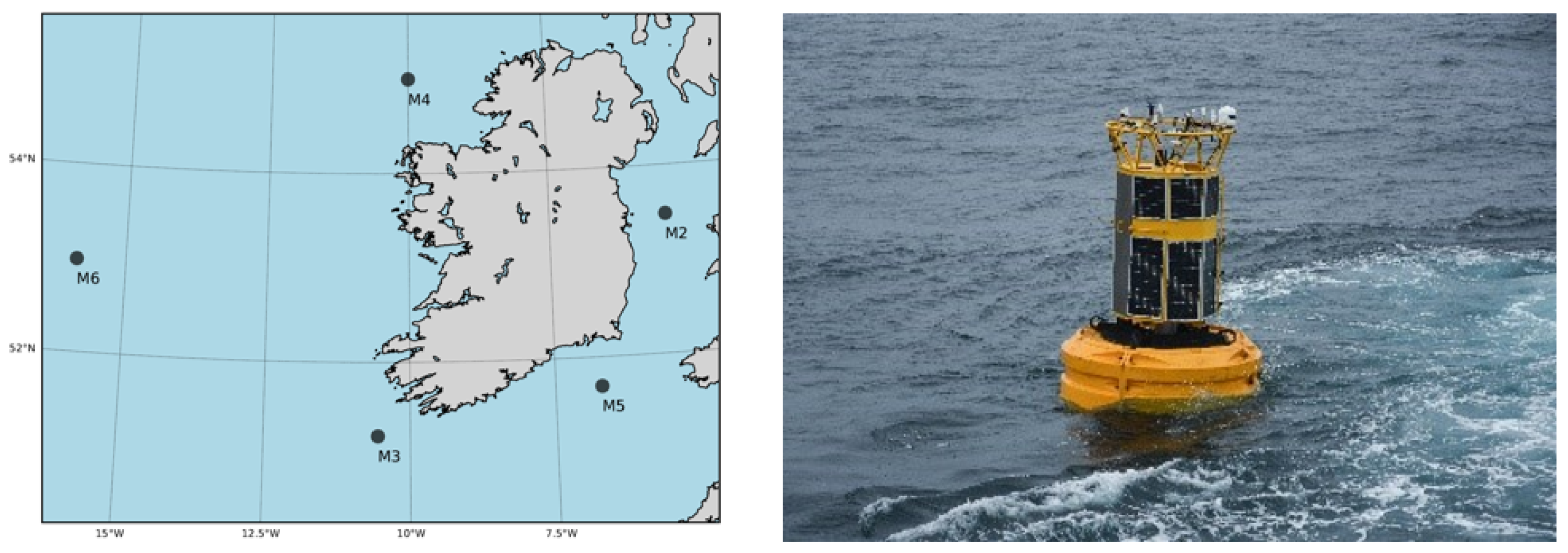
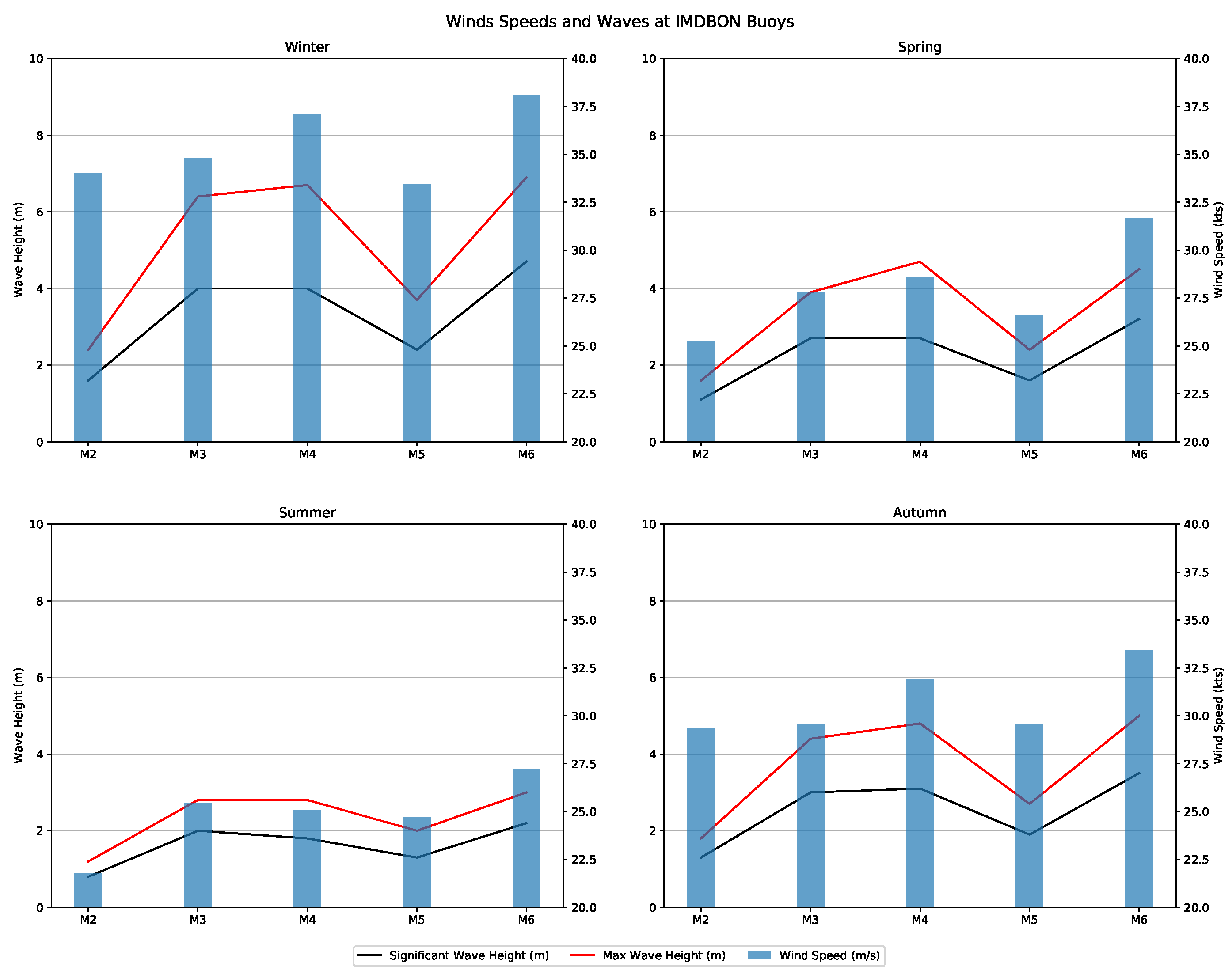
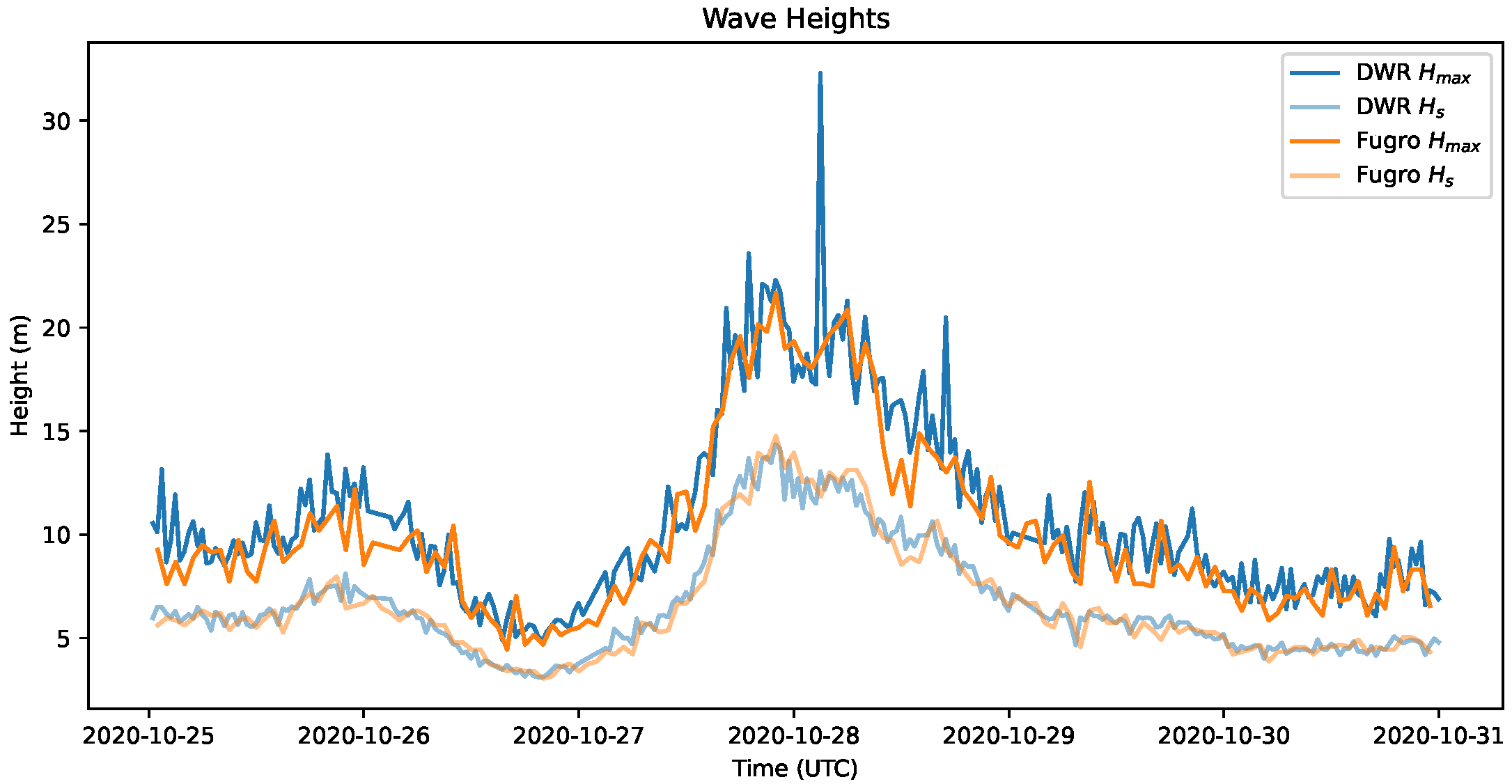

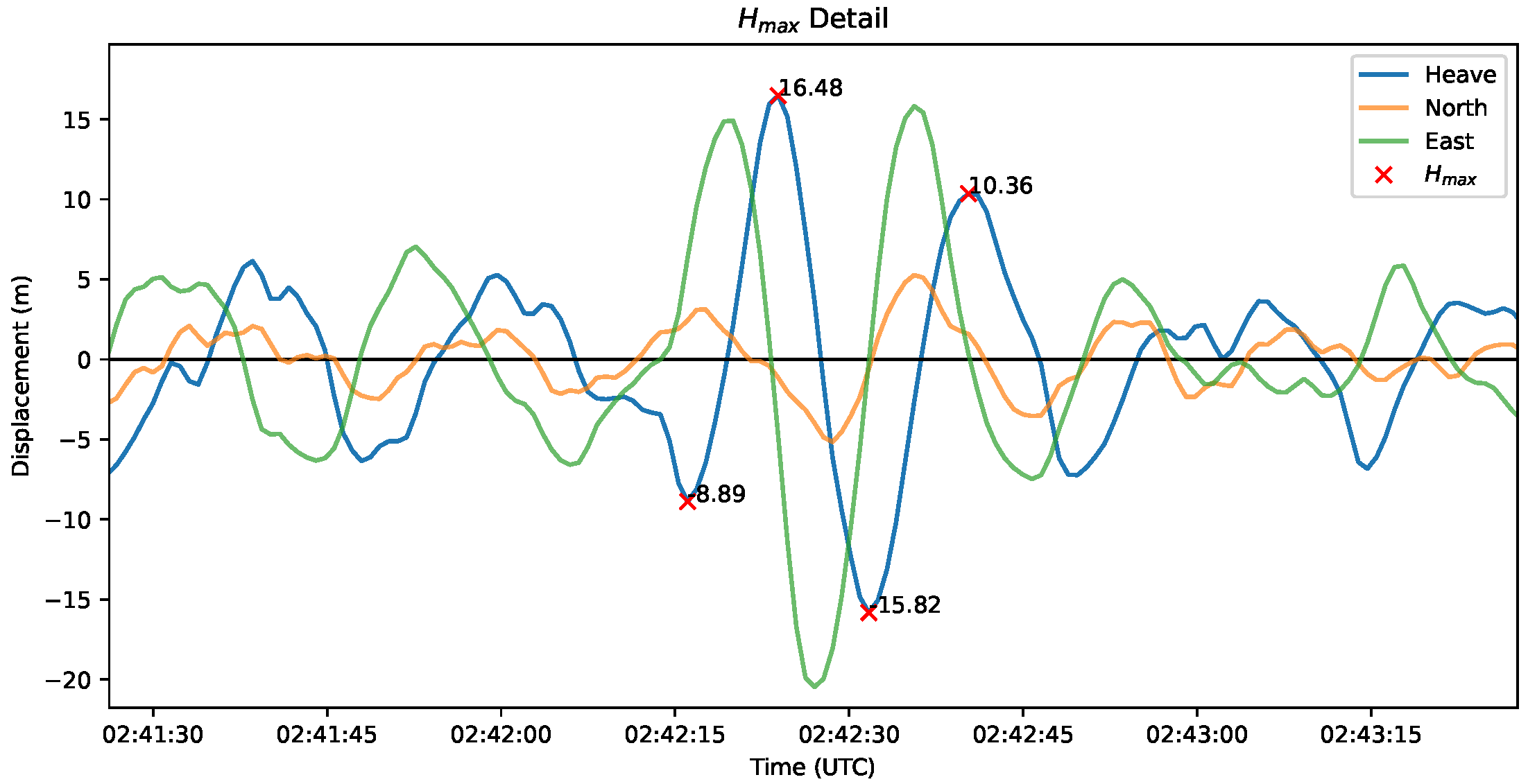
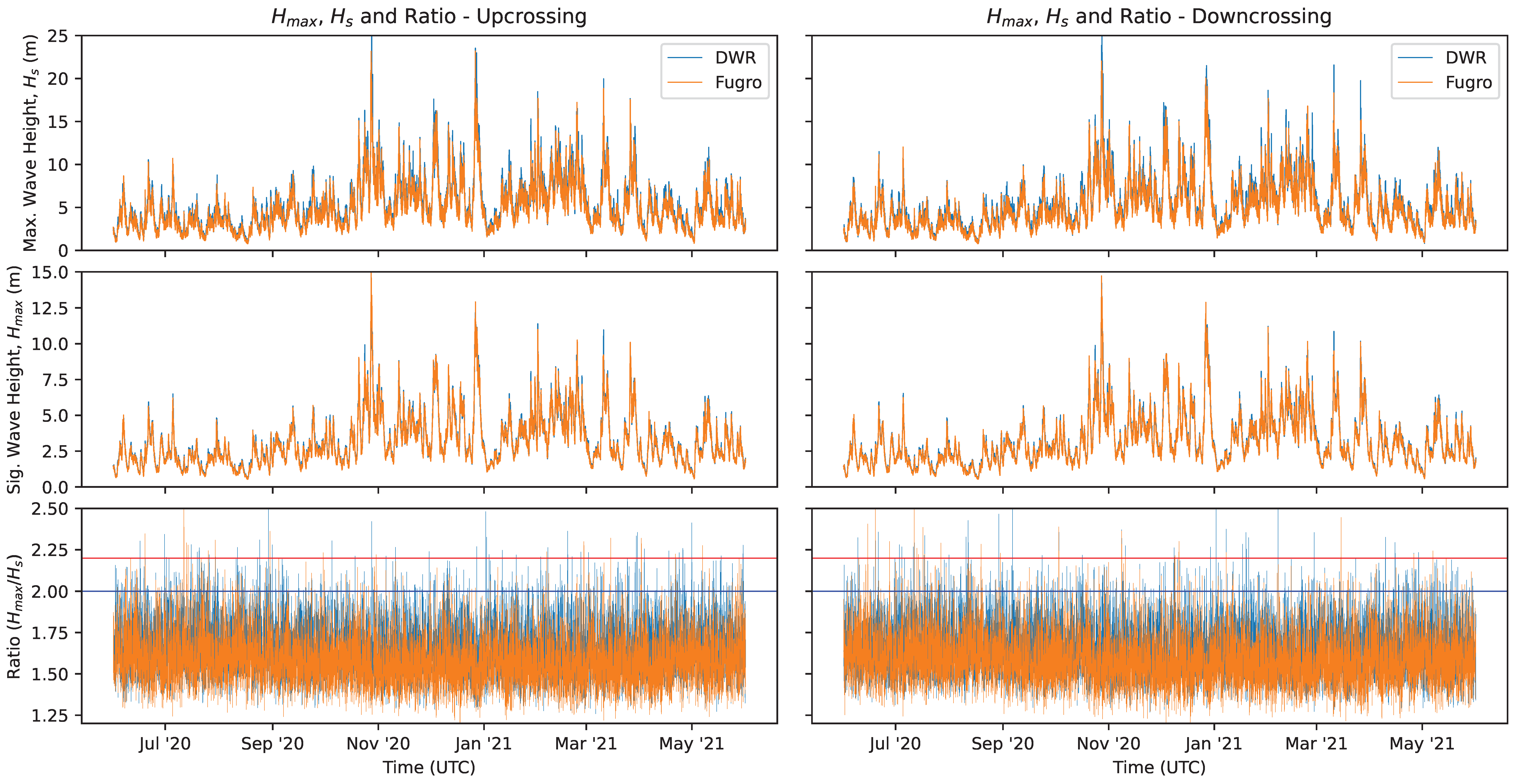
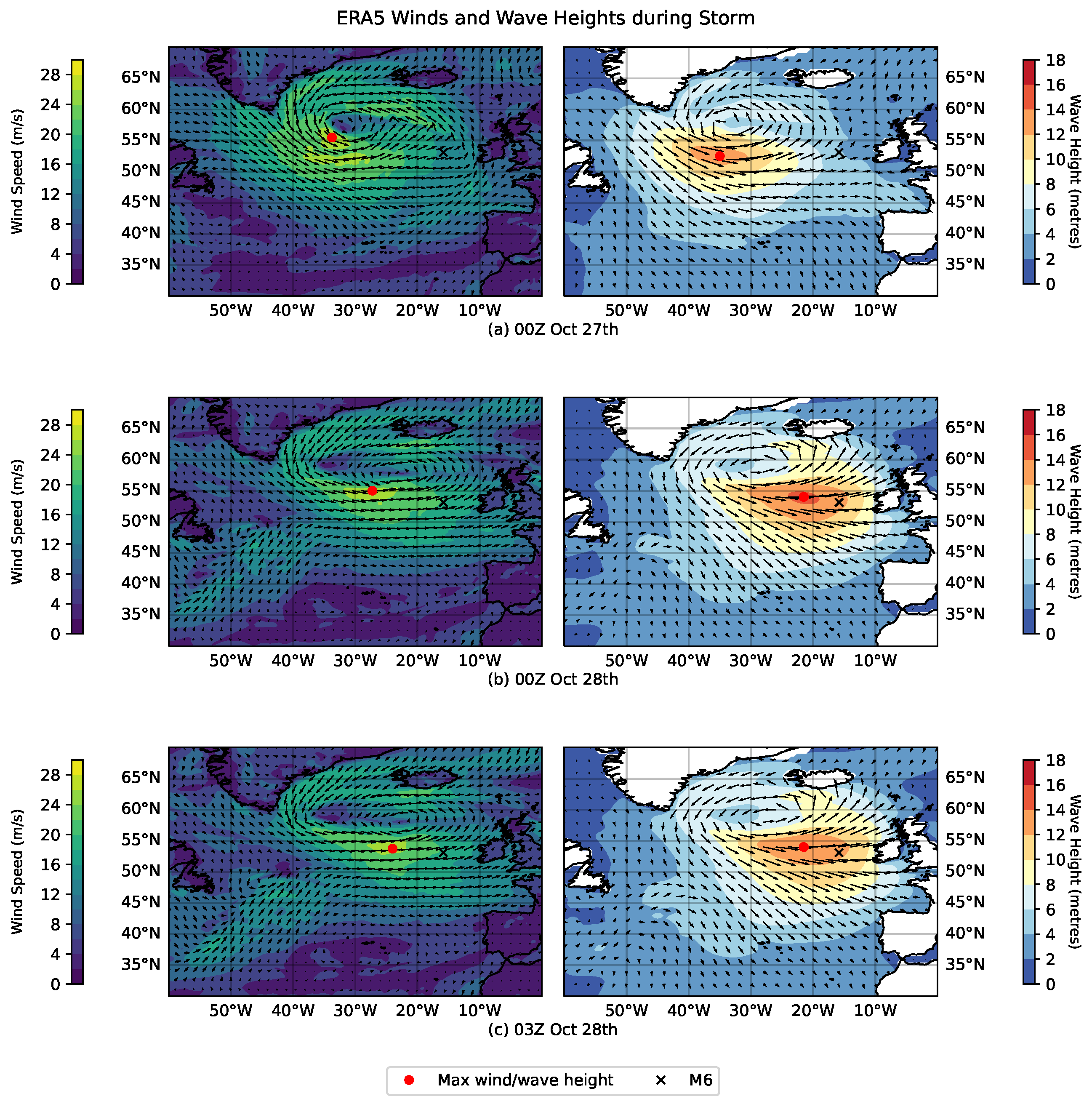

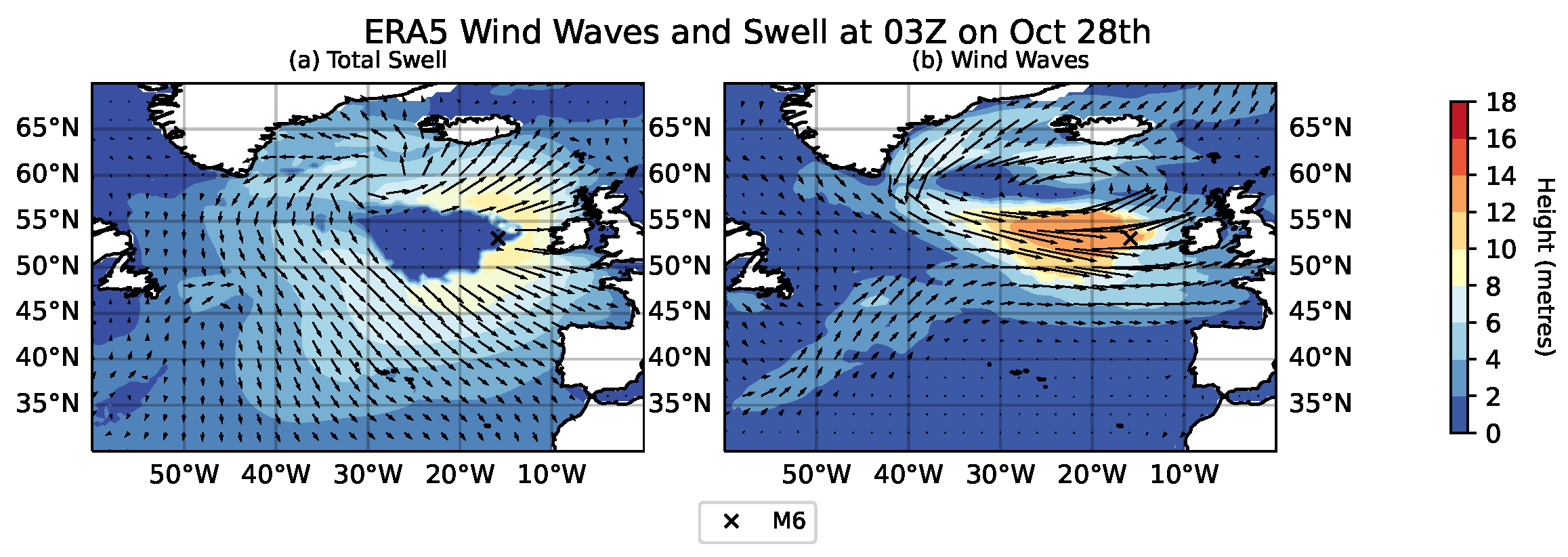
| Parameter | Pearson’s R | RMS Difference |
|---|---|---|
| 0.99 | 0.22 m | |
| 0.99 | 0.24 m | |
| 0.97 | 1.02 m | |
| 0.88 | 1.33 s | |
| 0.99 | 0.22 s | |
| 0.98 | 0.37 s | |
| 0.91 | 37.9° |
| Time (UTC) | Hm0 (m) | Tp (s) | Tm02 (s) | Mdir (Degrees) |
|---|---|---|---|---|
| 28 October 2020 02:00 | 13.05 | 20 | 12.79 | 265.1 |
| 28 October 2020 02:30 | 12.68 | 16.67 | 12.6 | 260.7 |
| 28 October 2020 03:00 | 14.07 | 20 | 13.09 | 270.1 |
| 2 × Hs | 2.2 × Hs | Crest 1.25 × Hs | ||||
|---|---|---|---|---|---|---|
| System | No. of Waves | Incidence Rate | No. of Waves | Incidence Rate | No. of Waves | Incidence Rate |
| Datawell (U-C) | 392 | 1.1 × 10−4 | 48 | 1.4 × 10−5 | 25 | 7.3 × 10−6 |
| Datawell (D-C) | 377 | 1.1 × 10−4 | 38 | 1.1 × 10−5 | n/a | n/a |
| Fugro WS (U-C) | 152 | 1.3 × 10−4 | 17 | 1.4 × 10−5 | 15 | 1.2 × 10−5 |
| Fugro WS (D-C) | 164 | 1.4 × 10−4 | 22 | 1.8 × 10−5 | n/a | n/a |
| Parameter | M6 | Andrea | Draupner |
|---|---|---|---|
| Water Depth | 3000 | 74 | 70 |
| 13.34 | 9.18 | 11.92 | |
| 16.48 | 14.97 | 18.49 | |
| 1.24 | 1.63 | 1.55 | |
| 32.3 | 22.88 | 25.58 | |
| 2.41 | 2.49 | 2.15 | |
| 25.37 | 21.14 | 25.01 | |
| 1.90 | 2.3 | 2.10 | |
| Steepness (uc/dc) | 0.074/0.058 | 0.102/0.094 | 0.096/0.093 |
| Period | 16.7 | 12.0 | 13.1 |
| 1.28 | 1.33 | 1.17 | |
| Vertical Asymmetry (uc/dc) | 0.51/0.65 | 0.65/0.71 | 0.72/0.74 |
| Sensor | No. Rogues | No. Rogues > 10 m | No. Non-Rogues > 10 m | Mean Hs (m) | Mean Hmax | Max Hmax |
|---|---|---|---|---|---|---|
| Wavesense | 242 | 22 | 582 | 2.904 | 4.544 | 21.68 |
| Datawell | 1061 | 116 | 987 | 2.971 | 5.149 | 32.3 |
Publisher’s Note: MDPI stays neutral with regard to jurisdictional claims in published maps and institutional affiliations. |
© 2022 by the authors. Licensee MDPI, Basel, Switzerland. This article is an open access article distributed under the terms and conditions of the Creative Commons Attribution (CC BY) license (https://creativecommons.org/licenses/by/4.0/).
Share and Cite
Nic Guidhir, M.; Kennedy, D.; Berry, A.; Christy, B.; Clancy, C.; Creamer, C.; Westbrook, G.; Gallagher, S. Irish Wave Data—Rogues, Analysis and Continuity. J. Mar. Sci. Eng. 2022, 10, 1073. https://doi.org/10.3390/jmse10081073
Nic Guidhir M, Kennedy D, Berry A, Christy B, Clancy C, Creamer C, Westbrook G, Gallagher S. Irish Wave Data—Rogues, Analysis and Continuity. Journal of Marine Science and Engineering. 2022; 10(8):1073. https://doi.org/10.3390/jmse10081073
Chicago/Turabian StyleNic Guidhir, Méabh, Donal Kennedy, Alan Berry, Barry Christy, Colm Clancy, Columba Creamer, Guy Westbrook, and Sarah Gallagher. 2022. "Irish Wave Data—Rogues, Analysis and Continuity" Journal of Marine Science and Engineering 10, no. 8: 1073. https://doi.org/10.3390/jmse10081073
APA StyleNic Guidhir, M., Kennedy, D., Berry, A., Christy, B., Clancy, C., Creamer, C., Westbrook, G., & Gallagher, S. (2022). Irish Wave Data—Rogues, Analysis and Continuity. Journal of Marine Science and Engineering, 10(8), 1073. https://doi.org/10.3390/jmse10081073






